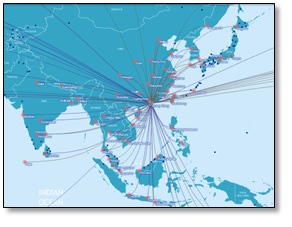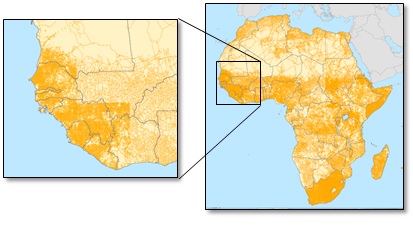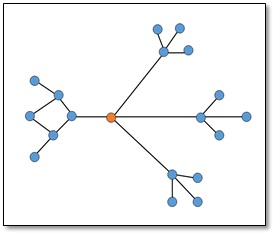There’s a downside to modern travel and trade networks: pests and pathogens hitch a ride. Nowadays, as a 2014 CSIRO report shows, the question isn’t ‘if’ something nasty arrives – it’s ‘when’. Worldwide trade and transport networks bring phones from China, cashews from India, Vietnam and Nigeria, and Brazil nuts from Bolivia, take you on exotic holidays, and help pests and pathogens move around the globe.
Once, outbreaks of disease mostly stayed where they began – until recently the case for diseases like Ebola. But moving people and things all around the world changed that. One example is the Spanish Flu pandemic of 1918. It spread following the path of its human carriers, along trade routes and shipping lines, in the mass movement of people and goods caused by World War I.
Much the same is true for pests. Interconnected world trade systems increase the chance of inadvertently transferring more than was intended. Our article in Ecology Letters looks at why networks are important, how they spread pests and pathogens, and how understanding them may help prevent further spread.
Why networks matter
Global trade and transportation networks (GTTNs), the Worldwide Airline Network, Global Cargo Shipping Network and Global Road Network, connect the world’s major ports and cities to towns, villages and remote wilderness via millions of kilometres of road, air and shipping lanes.
Network scientists are looking at network structural patterns that help spread exotic diseases and pests. These can dramatically increase the speed and size of epidemics and pest invasions.
How networks contribute to the spread of pests and pathogens
Scale-free Networks
Networks with scale-free properties are those where most towns, cities or ports—nodes— have only a few links to other nodes. Some nodes become hubs, with links to many other nodes. The Worldwide Airline Network (WAN) connects through hub airports like London-Heathrow, Dubai and Hong Kong. Infectious diseases and pests can spread easily and quickly, getting to many different places within hours. This is how SARS spread from Guangdong in China: via Hong Kong. It reached 37 countries, infecting over 8,000 people within weeks. Pests or pathogens moving on the WAN can lead to a fast moving, widespread pandemic.

Small-world Networks
In other networks – small-world networks – most nodes have similar numbers of links to and from each other. The Global Road Network is an example. Networks can be highly clustered into regional communities, with shortcuts between different nodes. Clusters may be densely connected internally but less well-connected to each other. When a pathogen emerges in one cluster and spreads via such a network, it can travel widely within the well-connected community but be relatively confined within it. An example is the current Ebola outbreak, which spread widely in the West African region but less successfully to other parts of the network. Networks with small-world properties may produce faster, denser epidemics within communities, but slower epidemics over the global network.

Network Connectivity
The way global networks are connected may also affect the way pests and pathogens spread. Each new trade and transport connection increases the density of linkages in the overall network. This improves the mobility of people and goods between any two points in the system, but does the same for pests and pathogens. How these links are configured is important: particular cities and links between otherwise disconnected communities can let pests and pathogens jump geographic barriers. Without that link, a pest or disease is more likely to remain isolated.

All this suggests that pests and pathogens move differently depending on the network. There are many other considerations in the spread of pathogens, but epidemiologists and health experts can gain new insights by identifying network structural patterns and considering networks in analyses of current outbreaks.
Can understanding networks help prevent epidemics and pest invasions?
Understanding the structure of GTTNs makes us better able to control epidemics in their early stages. By pinpointing network areas most vulnerable to infections and invasions, and those with the greatest spread potential, we can use our limited resources where they will be most effective. Focusing surveillance, quarantine and vaccination efforts at specific points— such as hubs near infection sources, strategic parts of regional clusters and central connecting nodes— can reduce the impact of epidemics and invasions.
REPORT AUTHORS
Natalie Banks - PhD Student with Plant Biosecurity CRC, Murdoch University & CSIRO
Dean Paini - Research Scientist at CSIRO
Kirsty Bayliss - Senior Lecturer (Biosecurity Science) at Murdoch University
Mike Hodda - Senior Research Scientist at CSIRO, and Adjunct Professor at the Australian National University and Charles Sturt University
DISCLOSURE STATEMENT
This research is supported by the Plant Biosecurity Cooperative Research Centre (PBCRC), Murdoch University and the Biosecurity Flagship of the Commonwealth Scientific and Industrial Research Organisation (CSIRO).
NOTES:
